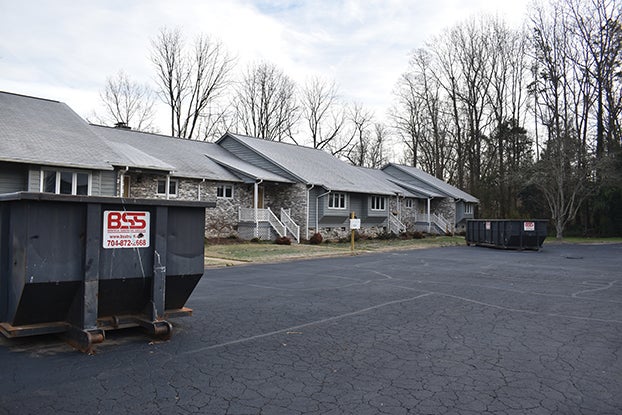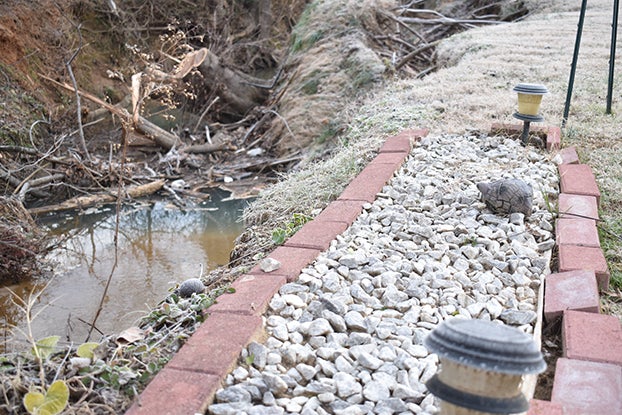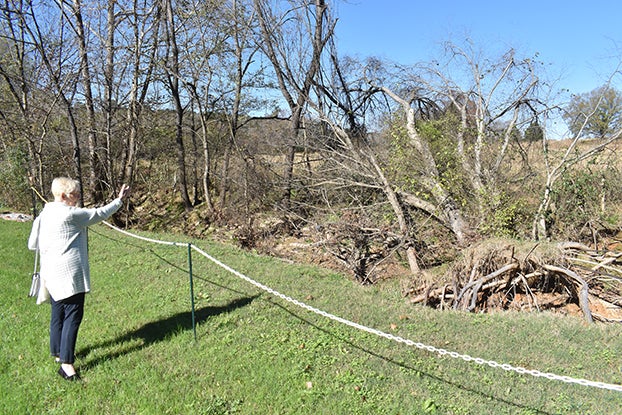Residents of Wellington Hills search for answers, worry about what could come next
Published 12:10 am Tuesday, December 29, 2020

- Building 200 of the Wellington Hills community was flooded in August. With the new year approaching, the building remains vacant as its residents wait for it to be rehabilitated. Ben Stansell/Salisbury Post
Editor’s note: This is the second in a two-part series looking back at a massive rain storm in August that submerged a neighborhood and forced people from their homes. The first part was published Sunday on page 1A.
Michele Joy said that she remembers the first time she saw water from Jump and Run Branch creek overcome its banks. It was in the summer of 2018, about a month before Hurricane Florence hit the Carolinas.
“That was the first time it had done it, where the five of us, the current homeowners, have ever seen it that I know of,” Joy said. “We were all like ‘What the heck?’”
Joy is one of six residents who live in building 200 of the Wellington Hills neighborhood, all of whom were displaced by the flood on Aug. 31. Joy is not alone when she said she believes that rain storms are only getting more severe, both in quantity and intensity.
Brenda Goins said that she thinks the rain is just getting “worse and worse.”
Brian Fannon, riverkeeper for the Yadkin Riverkeeper organization, said that Joy’s and Goins’ shared observation isn’t surprising. Heavier rains in more inconsistent bursts was something projected several years ago by the Intergovernmental Panel on Climate Change.
“When looking at climate change, a lot of the focus is on coastal areas where you’re looking at a permanent water level rise,” Fannon said. “But climate change planning for a lot of cities is going to involve the realization that the way that rain is delivered is going to change.”
After the flood on Aug. 31, Peggy Ricke composed a video montage of heavy rain events from the last few years — the first of which was shot on Oct. 11, 2018, when the waters of the creek were surging but not quite overflowing. The montage contains a few more videos, in each one the water getting closer and closer to the building until Aug. 31, 2020, when the water was coming up the steps.
It’s clear that rain was the major factor in the flood, but Ricke and her neighbors harbor a few theories about what else could have contributed to its magnitude.
For one, Ricke said, the creek has been eroding for years. Ricke even installed a rock bed in her backyard and said that she’s used it to see how much closer the bank of the creek has gotten to their home.

Peggy Ricke said that she installed this rock garden in her backyard several years ago to gauge the erosion of the Jump and Run Branch creek. Ben Stansell/Salisbury Post
The erosion of the creek has been a red flag for Sacred Heart Catholic Church and the Diocese of Charlotte, who owns the large tract of land just across Jump and Run Creek from building 200.
As the creek’s sides have eroded, nearby trees have fallen into the Jump and Run Branch. One particularly large tree, which fell across the creek from the Wellington Hills side, had been sitting in the creek for several months before the day of the flood.
While the tree was likely not a factor in causing the flood, the church has since chopped it up and placed the limbs along its side of the creek.
In a statement to the Post, a spokesperson for the Diocese of Charlotte said that the creek has been “seriously eroding its banks for years” and that the diocese periodically clears the larger fallen trees when ground conditions allow and places them along the bank to further stem the erosion.
The diocese also said that it wants to see action taken to improve the creek’s conditions.
“Staff from the parish and the diocese have been in touch with our neighbors in the Wellington Hills community to express our concerns for their well-being after the unprecedented flooding last August,” the statement reads. “Like them, we are adversely affected by the chronic flooding and have reached out to local officials to see if there is something they can do to resolve what appears to be a public stormwater management issue impacting this entire area.”

Peggy Ricke points at a large tree that was sitting in Jump and Run Branch Creek. Although the tree likely didn’t contribute to the flood, the Archdiocese of Charlotte has had it chopped up. Ben Stansell/Salisbury Post
Chris Tester, assistant public works director for the city of Salisbury, said that creek erosion is often linked to development along its banks.
“What protects a stream is the root structure of all the plants that are growing there,” Tester said. “When somebody goes in and clears all the way to the stream bank, when you get flooding and receding water and stuff like that, that root structure has died and the soil can’t support those high flow rates without that root structure in there to help hold it together.”
Ricke theorizes that the worsening flood conditions could be linked to an apartment development up creek from Wellington Hills. The apartment complex, called Britton Village, is still under construction.
“There’s an apartment complex that was built up there off Statesville Boulevard and it sort of started happening then,” Ricke said. “That’s when we all think the water started. I’m not really sure.”
Ricke has floated her theory, which is shared in part by some of her neighbors, to officials with the city of Salisbury. Wendy Brindle, the city’s engineer, said that they investigated the apartment complex’s construction site after hearing some of the residents’ concerns, but cleared the complex of any impact on the flooding.
“When we were out there, it was functioning as it should,” Brindle said.
Rowan County’s Erosion Control Specialist Greg Greene did report that there were a few minor issues at the apartment’s construction site.
In an email to Brindle, Greene reported: “Regrettably, at the beginning of this project, the contractor did not follow proper construction sequence and install the approved measures prior to considerable land-disturbing activity occurring. Consequently, some sediment loss occurred into the ravine below the basin and onto the adjacent property. I expect the storm event in question moved some that deposited sediment further downstream, but as of my recent inspection (9/8/20), the site was in substantial compliance.”
Brindle said that the sediment loss may have led to mud making its way to the Wellington Hills area, but that “it by no means contributed to the flooding.” That primary reason for the flooding, she contends, was the intensity of the rain.
Tester delivered the same verdict. The city as a whole, Tester said, receives a lot of stormwater runoff from the western and northern parts of the county, which are generally at a higher elevation. That water is headed toward the Yadkin River and makes its way through tributaries like Jump and Run Branch first.
Jump and Run Branch creek, Tester said, receives drainage from an area of 1,165 acres. He estimated that 75% of that area is in the county’s domain and 25% is in the city’s.
While the city of Salisbury has a stormwater program, Tester said, the county currently does not, nor is it currently required to. Even then, the stormwater program is to manage for pollution, not flooding, Tester said.
Tester said that there is not much that can be done to prevent a flood like the one that happened on Aug. 31. One thing that is achievable, he said, is ensuring that the Jump and Run Branch receives proper maintenance so that when the water does come hard and quick, it can move down the creek as fast as possible. That’s the responsibility, Tester said, of each landowner along the creek.
There’s another theory that has been floated around by some residents of building 200 and by Derron Dulkoski, the owner of The Revival Golf Course at The Crescent. They wonder if, when the rain came down on Aug. 31, the water in Jump and Run Branch had nowhere to go because Grants Creek and the Yadkin River were already overflowing themselves.
Fannon said that this theory was in the realm of possibility, but not likely. At least, not when it pertains specifically to the flooding of Wellington Hills. The amount of rain simply overwhelmed the runoff systems.
Ricke said that she’s talked to several officials about what can be done to improve the creek’s conditions, but has “basically given up.” Instead of thinking about how to prevent the next flood, she’s worried about what happens when it comes.
She’s not alone.
The next one
The residents of building 200 love living in the Wellington Hills community and they’re ready to be back in their condos. But the terror of what could’ve happened during the flood, or what might happen during the next one, will make it a timid return.
“My husband is disabled. He can hardly walk,” Judy said. “He has to use a cane. I was afraid he was going to fall inside because the water had gotten so deep. The floor had already started buckling. You could easily fall.”
Mike isn’t the only resident who was at a greater risk of falling during the flood. Goins underwent knee surgery just a few weeks before the end of August and was still using a cane to walk when she wasn’t recuperating in bed.
Joy said that what happened on the day of the flood was actually the best-case scenario. Two residents, Ricke and Byron, weren’t even home. And rescue crews were able to bring the four residents and the four pets who were home to safety. The rain also started in the afternoon, so there was enough light for residents and the rescue crews to see.
Joy shudders to think about what could’ve happened if the rain had started in the darkness.
“If this had happened at night, I am fairly convinced that either someone would have been seriously hurt or a pet would have died or one of us would have died,” Joy said. “There’s no warning, there’s no siren. There’s no noise from it. If it had been during a hurricane and the power was out, explain to me how Brenda (Goins), who had just had knee surgery, was going to be able to get out the door.”

Michele Joy took a photo of her car as the rain pounded down. Soon, her Kia was swept away in the current. Photo submitted.
The chances of another flood event like the one on Aug. 31 happening again are slim, but that doesn’t comfort Goins.
“Personally, every time it rains, I’m going to be terrified,” Goins said.
The residents all spoke glowingly of the community and said that they enjoy living there. But that doesn’t mean they necessarily want to go back. Ricke said that they “should just tear down the building and put in a dog park.”
But to some, moving back in seems like the only option.
“We don’t have a choice,” Goins said. “We have to move back in.”
In theory, they would have options to move out once they finally move back in. Even though Wellington Hills Homeowners Association owns the building, each resident owns their own unit and has the freedom to do with it what they want, Mintz said.
“It’s up to the HOA to rehabilitate the house and the units and then the keys will be given back to them,” Mintz said. “Then it’s up to them what they want to do.”
In 2009, before Mintz was involved in neighborhood leadership, someone from the Wellington Hills Homeowners Association purchased flood insurance for the building.
After the August flood, the city of Salisbury determined that the amount of damage was worth 67% of the cost of the building, Mintz said. Having that money allowed the HOA to rehabilitate the buildings, but since the residents didn’t have individual policies, they were not reimbursed for any personal belongings.
With keys in hand, the residents of building 200 could sell the units. But that could prove to be challenging after the flood, Ricke said.
“We’re going to have a problem selling because, if you put our address in to Realtor.com, it comes up and says FEMA flood area,” Ricke said.
While most of the residents said that they will likely return to live in the community that they love, the fear of another flood will continue to trouble their minds.
“I’m not going to be able to go to bed at night if rain is in the forecast,” Goins said. “It’s just scary.”
Mintz said that plumbers and electricians have begun working on building 200 and that the units should be ready in a few months.
Those interested in helping the residents of building 200 or finding out more about the flood can reach out to Gail Mintz at me_gp_mintz@yahoo.com or at 704-639-0323.





